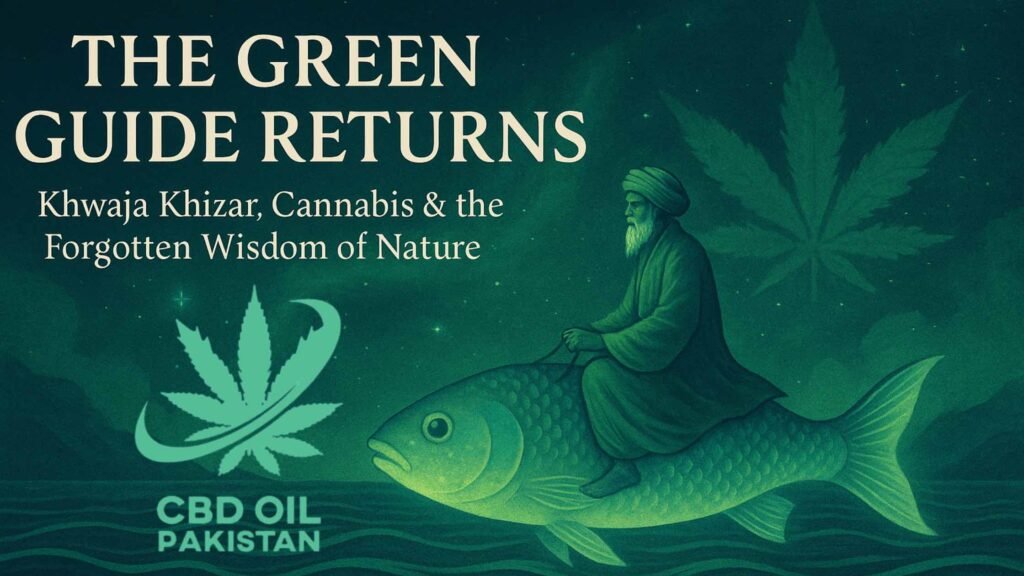🧭 Who Is Khwaja Khizar?
In Islamic and South Asian spirituality, Khwaja Khizar — also known as Al-Khidr — is a mysterious, immortal figure associated with guidance, greenery, and divine wisdom. His name comes from the Arabic root kh-d-r, meaning green. He is said to appear near rivers, gardens, and forests — especially during times of inner or outer crisis — as a guide for those who seek truth beyond reason.
In the Qur’an (Surah Al-Kahf, verses 60–82), Khidr is introduced as a servant of God possessing ʿilm ladunnī — divinely endowed knowledge — and imparts lessons to Prophet Musa (Moses) that challenge rational understanding. This narrative makes him an enduring symbol of hidden wisdom and divine trust.
In South Asian Sufi traditions, Khwaja Khizar is deeply revered — often invoked as a protector of travelers, seekers, and mystics. He is believed to guide the hearts of those who have no teacher, initiating them through visions, dreams, and the whispers of nature.
🔱 Khwaja Khizar Riding a Fish: Myth, Art & Symbolism
Across folk art, oral traditions, and devotional poetry in Pakistan and North India, Khwaja Khizar is almost always depicted riding a fish — an image central to his mystique.
🐟 The Fish Motif
In Persian and Mughal miniature paintings, and later in Sindhi and Punjabi shrine art, Khizar is shown:
- Clad in green robes
- Riding a large riverine fish across cosmic waters
- Surrounded by the Fountain of Life or divine light
The fish represents his role as a navigator of the unseen — a guide through spiritual depth, chaos, and rebirth.
🖼️ Historical Depictions
 Source: Mughal miniature of Khidr riding a fish
Source: Mughal miniature of Khidr riding a fish

Source: 42 The prophet Khizr Khan Khwaja ca. 1760 Bibliothèque nationale de France, Paris.jpg

Source: A Persian manuscript depicting Elijah and al-Khiḍr (right) together at the fountain of youth.

Source: Victoria and Albert Museum – UK
📚 Scholarly Insight
- Dr. Amina Yaqoob (Folklore and Faith, 2014) traces the fish motif in Sindhi oral storytelling and shrine iconography.
- Ananda K. Coomaraswamy sees the fish as a symbol of immortality and divine navigation.
- A Dawn article describes Khwaja Khizar of Sukkur as “white-bearded, turbaned, in green robes, riding a fish (palla) known for swimming against strong currents.”
📜 Source: Mythology of Khwaja Khizar – DAWN PDF
🌿 The Green Saint and the Sacred Leaf: Khwaja Khizar, Cannabis, and Sufi Reverence
Though cannabis (bhang, hashish) is not directly linked to Khizar in scripture, South Asian mystical traditions often associate him with plant-based insight — especially calming herbs that support contemplation and altered states.
Used in:
- Sufi meditation rituals
- Unani and Ayurvedic medicine
- Folk healing traditions of Punjab and Sindh
🌱 Cannabis becomes part of Khizar’s green domain — a silent, natural guide for seekers. In many South Asian Sufi traditions, Khwaja Khizar—the Green Guide—is not only the patron of water and rivers but is also deeply connected to cannabis (bhang) as a symbol of spiritual continuity.
A traditional saying (cited in Cannabis: A History by Martin Booth and other sources) captures this beautifully:
“The Sufis have a patron saint of cannabis – Prophet Al‑Khidr, the Green One. They drink bhang to honor him.” -Cannabisculture
Likewise, an Sufi alchemical text observes:
“The holy spirit in bhang… is the spirit of the great prophet Khizr, or Elijah. Khizr means green—the revered color of the cooling water of bhang.”
It continues: “When I quaff fresh bhang I liken its color to the fresh light of thy youthful beard.” -Alchemical Lab
🧙 Ibn al-ʿArabi and Khidr: Divine Knowledge Beyond Time
🌌 Ibn al-ʿArabi: The Greatest Mystic of Islam & the Metaphysics of Oneness
Muḥyiddīn Ibn al-ʿArabi (1165–1240), often referred to as Shaykh al-Akbar (The Greatest Master), is one of the most profound mystical thinkers in Islamic history. A towering figure of Sufism, he authored over 800 works — including Futūḥāt al-Makkiyya and Fuṣūṣ al-Ḥikam — that map the inner worlds of the soul, divine reality, and spiritual initiation.
His central doctrine, Wahdat-ul-Wujūd (Unity of Being), posits that all existence is a manifestation of the One Divine Essence. Everything seen, felt, or experienced is not separate from God, but a veil upon the Real (al-Ḥaqq). To awaken is to pierce that veil — and see with the “eye of the heart.”
🌀 Sufi Non-Duality & Shamanic Echoes
This metaphysical view closely mirrors non-dual traditions across cultures:
-
In Shamanism, it is said that trauma, psychosis, or ego-collapse can lead to soul retrieval or awakening — where the self disintegrates, only to return aligned with the natural and spiritual world.
-
In Taoism, the interplay of yin and yang creates harmony through polar opposites — not conflict, but complement.
-
In energy healing traditions, spiritual crises (often triggered by loss, grief, or depression) are pathways to inner transformation — through kundalini arousals, aura purification, or plant medicine journeys.
Like the Sufi seeker, the shaman or healer must first walk into the fire — what Ibn al-ʿArabi calls “the station of bewilderment” (ḥayra) — before they can emerge into gnosis.
🔗 Ibn al-ʿArabi and the Green Guide
It is no surprise, then, that Ibn al-ʿArabi’s spiritual initiator was Khidr (Khwaja Khizar) — the mystical archetype of the wilderness, the unknown, and divine guidance beyond reason. For Ibn al-ʿArabi:
“Khidr is the eternal teacher of the solitary ones — those who walk the unseen path.”
Their meeting in Seville, as recorded in Futūḥāt al-Makkiyya, was not just an encounter — it was a non-verbal initiation, passed through presence, not ritual.
Ibn al-ʿArabi viewed Khidr not as legend, but cosmic initiator.
He represents:
- ʿIlm Ladunnī — divine knowledge
- Hidden guidance
- Connection with nature
For Ibn al-ʿArabi, Khidr is the green current running through creation — the archetype of awakening through stillness, nature, and spiritual solitude.
🧳 Ibn al-ʿArabi, the Box, and Khwaja Khizar’s Invisible Hand
When Diriliş: Ertuğrul aired in Pakistan — especially during Prime Minister Imran Khan’s tenure — it wasn’t just watched — it became a cultural phenomenon. Among its most arresting scenes is one in which the mystical Sufi figure Ibn al‑ʿArabi hands a locked wooden box containing his shirt to Ertuğrul Bey, with instructions to open it only in a moment of profound existential crisis. This scene (“Ertugrul Season 1 Episode 6”), while fictional, is metaphor-laden and resonates deeply with real Sufi notions of spiritual lineage and interior guidance.
In Season 1, Episode 6 of the iconic Turkish series Diriliş: Ertuğrul, a pivotal mystical moment unfolds. In this scene, Ibn al‑ʿArabi—the revered Sufi guide—is seen conveying a vision of Khwaja Khizar (Al-Khidr) and the legendary Fountain of Youth to Ertuğrul. This powerful mythology is woven into the narrative, subtly illuminating the theme of divine life and esoteric awakening.
Scene Breakdown:
-
Setting: A visionary encounter in a quiet, candle-lit tent where Ertuğrul—disheartened after enduring personal and political trials—seeks solace and direction.
-
Mystical Imagery: Ibn al‑ʿArabi describes Khizar as the ever-green guide who drank from the spring of life, achieving immortality through divine grace, not natural death.
-
Symbolic Significance: The Fountain of Youth is not literal—a mythical spring granting eternal life. Rather, it represents spiritual regeneration, inner transformation, and the unbroken thread of hidden wisdom that continues from Khizar to those attuned to the Divine.
This narrative echoes legends drawn from Sufi and Islamic lore, where Khidr accompanies Dhul-Qarnayn (Alexander the Great) in search of the Ayn al-Hayat (Water of Life)—a water that grants immortality only to the purified. These stories emphasize that true longevity lies not in remaining physically alive, but in sustaining continuity of spirit, insight, and remembrance.
Why It Matters
For viewers or readers new to Sufi symbolism:
-
It reinforces the idea of spiritual apprenticeships that transcend time, geography, and logic.
-
The legend of the water of life dovetails with the concept of Khizar as the Guardian of hidden truths, ever-present in the metaphysical domain.
-
It beautifully aligns with your overall theme: Cannabis, as part of Khizar’s green symbolism, serves not as an escape, but as a doorway to spiritual vitality—just like the Fountain of Youth in myth.
The Chain of Transmission: From Khizar to Ertuğrul
In Sufi tradition, spiritual transmission is not always direct; sometimes, wisdom passes silently — through presence, ritual artifacts, or dreams. The drama captures this through the symbolic khirqa (initiation cloak) — embodied in that box of clothing.
The lineage behind this reaches back to the mystical Green Guide himself:
Khwaja Khizar → Ibn al-ʿArabi → Ertuğrul
In his magnum opus Futūḥāt al‑Makkiyya, Ibn al‑ʿArabi recounts:
“I met al‑Khidr in Seville… he initiated me into the order of the solitary ones (al‑Afrād).”
This was not a formal ceremony, but an initiation of the soul — non-verbal, timeless, and deeply internal.
Why the Box Matters
In the show, the box and shirt are not mere props — they represent spiritual inheritance across generations. Khizar’s guidance, distilled within Ibn al‑ʿArabi, is passed invisibly to Ertuğrul. The sacred relic isn’t just a token; it’s a safe deposit of unseen protection, to be opened only when human understanding fails.
A Symbol That Speaks Across Time
For the viewer — and especially for someone new to Sufism — this scene subtly illustrates a devotional truth:
-
Spiritual wisdom doesn’t always come through words.
-
Sometimes it’s preserved in traditions, relics, or silent presences, waiting for the right moment to unfold.
-
Khizar’s lineage moves in silence, through the green current of intuition, history, and symbolic memory.
🧭 The scene reminds us: True initiation is timeless, and those walking the path of courage and inner truth are never alone — even when they appear to be.
🪔 The Fakir by the River: A Story of Khizar’s Green Wisdom
One evening, along the banks of the Indus, a wandering fakir sat beneath a neem tree, sipping bhang brewed with sacred herbs.
A curious seeker asked,
“Why this green brew, baba?”
The fakir replied:
“This is not for intoxication, beta.
This is Khizar’s cup.
The leaf opens what noise closes.
It slows the breath, softens the ego, and prepares the heart for silence.
When there is no guide, he comes — not always in form, but in stillness.
And when he comes, all that remains is green.”
He smiled, “Khizar never teaches with books — only rivers, trees, herbs, and silence.”
📜 Rooted in Sufi Oral Tradition
- Draws from Qalandari and Malamati teachings in Sindh & Punjab
- Cited by Idries Shah (The Way of the Sufi): “Khidr may appear to the sincere seeker who lacks a physical guide — especially in wilderness, or while communing with plants and rivers.” (p. 213)
🧾 Allama Iqbal & The Symbolic Use of Hashish in Khizr-e-Rah
Among the most powerful literary tributes to Khwaja Khizar in modern Islamic thought comes from Dr. Allama Muhammad Iqbal, who devoted an entire philosophical poem titled Khizr-e-Rah (The Way of Khizar) to this mystical figure.
In this poem, Iqbal doesn’t just mention Khizar — he positions him as a timeless spiritual guide, a Sufi-like wanderer who appears at moments of civilizational crisis to offer truth beyond reason. Just as Sufis revere Khizar as the Green Guardian of Divine Knowledge, Iqbal presents him as a symbol of moral clarity, courage, and inner awakening in a world sedated by materialism and colonial subjugation.
It is within Khizr-e-Rah that Iqbal also introduces the metaphor of “barg-e-hasheesh” (the leaf of hashish) — a deeply symbolic critique, not of the plant itself, but of society’s tendency to seek numbness over consciousness.
“Barg-e-Hasheesh se badtar hai woh qoumein jin mein
Paiwastagi-e-fikr-o-amal ho na sakhi.”
(Worse than the leaf of hashish are the nations where
Thought and action are not united.)
He warns of mental numbness, but in another verse, he clarifies:
“Sahir-e-Maut ne tujh ko diya barg-e-hasheesh,
Aur tu aye bekhabar samjha use shakh-e-nabat.”
(The magician of death gave you the leaf of hashish,
And you mistook it for a healing plant.)
⚠️ Lesson: Cannabis can heal or numb — intention matters.
🧠 The Qur’anic Story: Musa & Khidr — Trusting the Unseen
In Surah Al-Kahf (verses 60–82), the Prophet Musa (Moses) embarks on a journey to seek a man more spiritually enlightened than himself — a mysterious servant of God known as Khidr (Khwaja Khizar).
They set off together, but Khidr warns:
“You will not be able to bear with me patiently.”
— Qur’an 18:67
Soon after, Khidr performs three strange acts:
-
He scuttles a boat belonging to poor fishermen.
-
He kills a young boy seemingly without cause.
-
He rebuilds a crumbling wall in a town that denied them hospitality.
Each time, Musa protests — unable to comprehend the apparent injustice. But at the end of their journey, Khidr reveals the divine reasons:
-
The boat was damaged to protect it from being seized by a tyrant.
-
The boy would have grown into a source of deep grief for his pious parents.
-
The wall concealed treasure meant for two orphaned children — preserved until they were mature.
🔮 Takeaway: Trusting What You Cannot See
Khidr isn’t just a character — he is the living embodiment of hidden wisdom, the patron of spiritual patience, and the archetype of unseen guidance.
-
His lessons emphasize that truth isn’t always visible on the surface.
-
Logic alone cannot unlock divine wisdom.
-
Sometimes, what appears to be harm is actually protection — a theme echoed across Sufi poetry, shamanic healing, and even plant-based medicine traditions.
🔮 Takeaway: Khidr represents trust in unseen guidance.
🔬 Science Confirms What Sufis Intuited
Modern research now supports traditional claims about cannabis:
- Anxiety reduction – Blessing et al., 2015
- Sleep improvement – Shannon et al., 2019
- Anti-inflammatory effects – Philpott et al., 2017
🌿 What mystics felt as “green wisdom,” science explains through endocannabinoid balance and the entourage effect.
🌱 Bridging Shamanic and Sufi Wisdom: The Biohack Bliss Ethos
At Shamanic Biohacker LLC, we honor the intersection of Sufi insight, shamanic ritual, and botanical science.
Our Botanical Blend (Full Spectrum Hemp Extract) reflects:
- Khizar’s green guidance
- Plant teachers that awaken consciousness
- Healing through nature, not sedation
🧘 Healing is remembrance — not escape.
Nature helps us remember.
📚 References (APA Format)
Blessing, E. M., Steenkamp, M. M., Manzanares, J., & Marmar, C. R. (2015). Cannabidiol as a potential treatment for anxiety disorders. Neurotherapeutics, 12(4), 825–836. https://doi.org/10.1007/s13311-015-0387-1
Coomaraswamy, A. K. (1943). Figures of Speech or Figures of Thought?
Ernst, C. W. (1997). The Shambhala Guide to Sufism.
Philpott, H. T., O’Brien, M., & McDougall, J. J. (2017). Pain, 158(12), 2442–2451. https://doi.org/10.1097/j.pain.0000000000001052
Rinella, M. A. (2012). Pharmakon: Plato, Drug Culture, and Identity in Ancient Athens.
Shah, I. (1991). The Way of the Sufi.
Shannon, S., Lewis, N., Lee, H., & Hughes, S. (2019). The Permanente Journal, 23. https://doi.org/10.7812/TPP/18-041
Yaqoob, A. (2014). Folklore and Faith.
Mythology of Khwaja Khizar – DAWN
- All
- Blog
- CBD Oil
- Vape

Hemp & Flood Prevention: Lessons from Thailand for Pakistan’s Climate Future

2025 Update: Full-Spectrum Hemp for Parkinson’s — Real Gains in Sleep & Cognition (What We Know About Tremor)

New 2025 Research: Full-Spectrum Hemp Provides Rapid Migraine Relief

New 2025 Study: CBD Oil Shows Promise in Protecting Organs During Chemotherapy

🌿 Khwaja Khizar & Cannabis: The Mystical Legacy of Green Wellness in Pakistan

CBD Oil Chemotherapy Protection Pakistan | 2025 Research

CBD and Autism in 2025: What New Research Reveals

CBD Oil in Pakistan for OCD: Can It Help Manage Symptoms Naturally?

Understanding CBD Oil Pricing in Pakistan: A 2025 Guide
As CBD oil continues gaining attention in Pakistan’s wellness market, a common question has emerged among consumers: Why is CBD oil so expensive in some

CBD Vape E-Liquid: Premium CBD Vape Juice Now in Pakistan
🌿 What is CBD Vape E-Liquid? CBD Vape E-Liquid—commonly referred to as CBD Vape Juice—is a specially formulated liquid infused with cannabidiol (CBD), designed for

CBD and Chronic Pain: A Scientific Perspective on Relief
Understanding Chronic Pain Chronic pain, characterized by persistent discomfort lasting longer than 12 weeks, affects millions globally and is a leading cause of reduced quality

CBD Oil and the Blood-Brain Barrier: A Trojan Horse for Brain Health
Cannabidiol (CBD), a powerful non-intoxicating compound found in the cannabis plant, continues to attract attention for its therapeutic potential. Beyond its use in managing pain

CBD Oil Islamabad
Introduction: The Rise of CBD Oil in Islamabad Islamabad, Pakistan’s capital city, is becoming more than just the country’s political hub — it’s emerging as

CBD Oil Pakistan Vape: Everything You Need to Know About the New Wellness Trend
Introduction: What Is CBD Oil Vape and Why Is It Trending in Pakistan? In recent years, the phrase “CBD Oil Pakistan Vape” has been gaining

